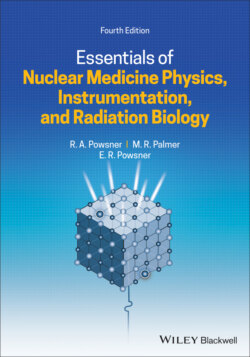Читать книгу Essentials of Nuclear Medicine Physics, Instrumentation, and Radiation Biology - Rachel A. Powsner - Страница 55
Annihilation
ОглавлениеThis interaction in matter most often involves a positron (positive electron) and an electron (negatron). After a positron has transferred most of its kinetic energy by ionization and excitation, it combines with a free or loosely bound negative electron. Recall that electrons and positrons have equal mass but opposite electric charge. This interaction is explosive, as the combined mass of the two particles is instantly converted to energy in the form of two oppositely directed photons, each of 511 keV. This is referred to as an annihilation reaction (Figure 2.11). It is another example of the interchangeability of mass and energy described in Einstein’s equation: energy equals mass times the speed of light squared, or E = mc2 (Figure 2.12).
